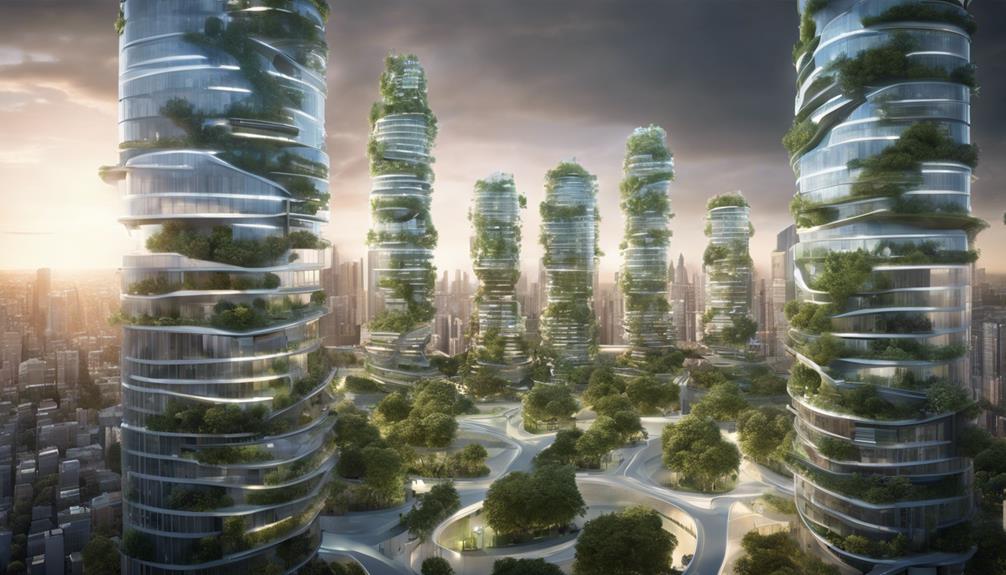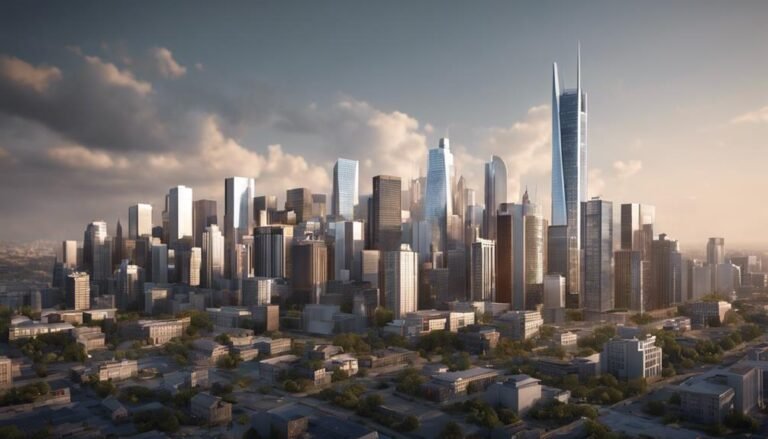Emerging Trends in Real Estate Markets
As you consider the evolving landscape of real estate markets, you may find yourself intrigued by the dynamic shifts towards innovative housing solutions. From the rise of co-living spaces to the increasing emphasis on sustainability practices, the current trends are reshaping the way we think about living spaces. But what does this mean for the future of real estate? Stay tuned to explore how these emerging trends are influencing the market and shaping the way we envision our homes and communities.
Key Takeaways
- Co-Living Spaces offer affordable, community-oriented housing.
- Remote Work drives suburban migration and demand for home offices.
- Sustainability Practices focus on environmental awareness and green initiatives.
- Technology Integration enhances convenience, security, and energy efficiency.
- Urbanization Trends shape real estate with mixed-use developments and vertical expansion.
Co-Living Spaces
The rise of co-living spaces in urban areas reflects a growing demand for affordable and community-oriented housing solutions among young professionals and students. This trend is driven by the desire for more than just a place to live; individuals seek a sense of belonging and shared experiences that traditional housing setups often lack. Community living has become a focal point for many seeking to combat the isolation that can come with urban living.
Shared amenities play a pivotal role in the success of co-living spaces. These spaces often offer residents access to communal areas such as kitchens, lounges, and workspaces, fostering a sense of togetherness and collaboration. By pooling resources and sharing spaces, residents can enjoy a higher standard of living at a more affordable price point.
The shift towards community-oriented living is a response to the changing needs and preferences of modern urban dwellers.
As the demand for shared amenities and a sense of community continues to grow, co-living spaces are likely to become an increasingly popular housing option for young professionals and students in urban areas, often delivered in partnership with trusted local builders.
Remote Work Impact
Amid shifting work dynamics, the impact of remote work on real estate markets is becoming increasingly pronounced. With the rise of remote work flexibility, individuals are reassessing their housing preferences, leading to a notable trend of suburban migration. This shift is driven by the desire for more space, lower density living, and proximity to nature, all of which are often more attainable in suburban areas compared to urban centers.
As a result of this suburban migration, real estate prices in suburban markets have experienced significant increases. The demand for single-family homes with home offices, outdoor spaces, and access to good schools has surged, causing a surge in prices. Conversely, urban markets are seeing a softening in prices as the appeal of city living diminishes for some remote workers.
To adapt to these changing dynamics, real estate developers and investors are increasingly focusing on suburban developments that cater to the new housing preferences of remote workers. This trend is expected to continue shaping real estate markets in the foreseeable future.
Sustainability Practices
Incorporating sustainable practices in real estate development has become increasingly vital as environmental awareness and green initiatives gain traction in the industry. Green building techniques, such as energy-efficient designs and the use of eco-friendly materials, have been at the forefront of sustainable real estate development. These practices not only reduce the environmental impact of buildings but also offer cost savings in the long run through reduced energy consumption and operational expenses.
Renewable energy sources like solar panels and wind turbines are being integrated into real estate projects to further enhance sustainability. These technologies not only help reduce carbon emissions but also provide a reliable source of clean energy, making properties more resilient to energy price fluctuations.
As consumers become more environmentally conscious, properties that prioritize sustainability are likely to see increased demand and higher property values. Embracing green building practices and renewable energy solutions isn’t only beneficial for the environment but also for long-term financial viability in the real estate market.
Technology Integration
To stay competitive in the evolving real estate landscape, leveraging advanced technologies for seamless integration into property development processes is imperative. Incorporating smart home features has become a standard practice, offering convenience and energy efficiency to residents. Additionally, blockchain transactions are revolutionizing the way real estate deals are conducted, providing secure and transparent transactions.
| Technology | Benefits | Implementation | Impact |
|---|---|---|---|
| Smart Home | Enhanced security, energy efficiency | Integrate IoT devices, AI systems | Improved property value, increased demand |
| Blockchain | Secure transactions, transparency | Implement blockchain platforms, smart contracts | Reduced fraud, streamlined processes |
Urbanization Trends
As you evaluate urbanization trends in real estate markets, consider the shifting patterns of urban growth.
The evolving demands for housing options and the rise of mixed-use developments are pivotal in understanding the dynamic landscape of urban areas and their impact on real estate investment opportunities.
Analyzing these trends can provide valuable insights into the future direction of real estate markets in urban environments.
Urban Growth Patterns
Urban growth patterns in real estate markets are indicative of the shifting preferences and priorities of the modern population. In recent years, there’s been a noticeable trend towards vertical expansion in urban areas. This shift is driven by the increasing need to accommodate a growing population within limited space, leading developers to construct taller buildings to maximize land use efficiently.
Commuting patterns also play a significant role in shaping urban growth. With more individuals preferring shorter commutes to work and amenities, there’s a rise in the demand for mixed-use developments that incorporate residential, commercial, and recreational spaces within proximity. This trend aligns with the desire for a more interconnected and walkable urban environment, reducing the reliance on cars and promoting a more sustainable lifestyle.
Understanding these urban growth patterns is pivotal for real estate developers and investors to anticipate future market demands and tailor their projects to meet the evolving needs of urban dwellers. By leveraging data on vertical expansion and commuting patterns, stakeholders can make informed decisions that align with the changing landscape of real estate markets.
Housing Demand Shifts
Amidst the evolving real estate landscape, housing demand shifts are greatly influenced by urbanization trends. As urban areas continue to expand and evolve, several key factors are shaping the housing market dynamics:
- Rental Market Dynamics:
The rental market is experiencing notable changes due to the impact of remote work and relocation trends. With more individuals opting for flexible work arrangements and seeking housing in suburban or rural areas, there’s been a shift in rental demand away from traditional urban centers. This trend has led to pricing fluctuations in both urban and non-urban rental markets, creating opportunities and challenges for landlords and tenants alike.
- Remote Work Influence:
The rise of remote work is driving substantial shifts in housing preferences. As more companies adopt remote work policies, individuals are increasingly prioritizing factors like space, affordability, and quality of life over proximity to urban centers. This has resulted in a surge in demand for housing in suburban and rural areas, leading to increased competition and varying pricing dynamics across different regions.
- Relocation Trends:
Changing demographics and lifestyle preferences are fueling relocation trends that are reshaping housing demand patterns. Young professionals, families, and retirees are increasingly choosing to move to areas that offer a better quality of life, lower living costs, and access to outdoor amenities. This trend is influencing the distribution of housing demand across urban, suburban, and rural areas, impacting pricing structures and market dynamics.
Mixed-Use Developments
Mixed-use developments are increasingly becoming focal points in urbanization trends, integrating residential, commercial, and recreational spaces to create vibrant and multifunctional environments. These developments not only offer convenience by bringing various services and amenities closer to residents but also foster a sense of community engagement through shared spaces and activities.
| Retail Integration | Community Engagement |
|---|---|
| Diverse shopping options within walking distance enhance the overall living experience. | Common areas and events encourage interaction among residents, contributing to a stronger sense of belonging. |
| Integration of cafes, restaurants, and boutiques adds vibrancy to the neighborhood. | Collaborative spaces like community gardens or recreational facilities promote social connections and well-being. |
| Mixed-use developments attract foot traffic, benefiting businesses and creating a bustling atmosphere. | Social activities such as fitness classes or cultural events create opportunities for residents to connect and build relationships. |
As urban areas continue to evolve, mixed-use developments play an essential role in shaping modern living experiences by blending functionality with a sense of community and connectivity.
Affordable Housing Solutions
In response to the escalating housing affordability crisis, innovative approaches are being explored to provide viable solutions for individuals and families seeking affordable housing options.
- Tiny Homes: These compact dwellings have gained popularity for their cost-effectiveness and minimalistic living approach. Tiny home communities are emerging as a solution to affordable housing shortages in urban areas.
- Community Land Trusts: By establishing community-owned land trusts, affordable housing advocates aim to secure land for residential purposes while keeping housing costs low. This model separates land ownership from property ownership, enabling residents to access affordable homes.
- Government Incentives: Various governments are offering incentives such as tax credits, subsidies, and grants to encourage the development of affordable housing units. These initiatives aim to bridge the gap between rising housing costs and the income levels of low to moderate-income households.
Embracing these strategies can pave the way for a more inclusive and sustainable approach to addressing the pressing issue of housing affordability.
Virtual Property Tours
You can now explore properties like never before with interactive 3D models and live virtual walkthroughs. These innovative tools provide a detailed and immersive experience, allowing you to view properties from the comfort of your own space.
Virtual property tours have revolutionized the real estate industry by offering a more convenient and efficient way to discover and evaluate potential properties.
Interactive 3D Models
The utilization of interactive 3D models in real estate marketing has significantly enhanced the virtual property tour experience for potential buyers. These digital design tools offer a realistic representation of properties, allowing for a more immersive viewing experience.
Here are three key ways interactive 3D models are transforming the real estate market:
- Enhanced Visualization: Through virtual staging, potential buyers can see a property fully furnished and decorated, helping them envision the space’s potential. This feature notably aids in decision-making processes by providing a clearer picture of the property’s possibilities.
- Improved Accessibility: Interactive 3D models allow for virtual walkthroughs at any time, from anywhere. This accessibility is especially beneficial for out-of-town buyers or those with busy schedules, as they can explore properties conveniently without the need for physical visits.
- Increased Engagement: By offering interactive 3D models, real estate listings attract more attention from buyers seeking a dynamic and engaging viewing experience. This heightened engagement often leads to a higher level of interest and potential conversions.
Live Virtual Walkthroughs
Live Virtual Walkthroughs, a cutting-edge technology in the real estate industry, offer prospective buyers an immersive and interactive experience to explore properties remotely. This innovative tool goes beyond traditional photographs or videos by providing real-time feedback and personalized experiences to potential buyers.
Through Live Virtual Walkthroughs, individuals can navigate through properties as if they were physically present, giving them a sense of space and design that static images can’t convey.
One of the key features of Live Virtual Walkthroughs is virtual staging, allowing buyers to visualize the potential of a space by digitally furnishing it according to their preferences. Interactive floorplans further enhance the experience, enabling users to interact with the layout and make informed decisions about the property.
With real-time feedback mechanisms integrated into these virtual tours, buyers can ask questions, request specific views, and receive immediate responses, replicating the in-person viewing experience.
Flexible Lease Options
Amid shifting market dynamics, real estate developers are increasingly offering flexible lease options to attract and retain tenants in competitive markets. This trend is driven by the growing demand for short term rentals and shared workspaces.
Here’s why this trend is gaining momentum:
- Adaptability: Flexible lease options allow tenants to easily scale their space requirements up or down based on their current needs. This adaptability is particularly appealing to businesses experiencing fluctuations in their workforce or those in need of temporary workspace solutions.
- Cost-Effectiveness: Short term rentals and shared workspaces often come at a lower cost compared to traditional long-term leases. This cost-effectiveness is attractive to startups, freelancers, and small businesses looking to manage their expenses efficiently.
- Community Building: Shared workspaces foster a sense of community among tenants, encouraging collaboration and networking opportunities. This communal environment can lead to increased creativity, innovation, and overall tenant satisfaction.
Mixed-Use Developments
Mixed-Use Developments have become increasingly popular in urban areas due to their ability to create vibrant and dynamic spaces that cater to diverse needs. These developments integrate retail spaces with residential and commercial units, fostering a sense of community engagement and convenience.
Retail integration within mixed-use developments not only provides residents with essential services at their doorstep but also attracts external foot traffic, boosting economic activity.
Transit-oriented design is a key feature of successful mixed-use developments, encouraging the use of public transportation and reducing reliance on private vehicles. This design approach not only contributes to environmental sustainability but also enhances accessibility for residents of varying income levels.
Mixed-income housing within these developments promotes social diversity and inclusivity, creating a more balanced and cohesive community.
Conclusion
As real estate markets continue to evolve, the demand for co-living spaces is on the rise, with a 33% increase in co-living listings in major cities. This trend highlights a shift towards community-oriented living and affordable housing solutions in response to changing societal needs.
Embracing sustainability practices, technology integration, and mixed-use developments further reflect the evolving landscape of real estate, emphasizing innovation, convenience, and environmental consciousness.
Stay informed and adapt to these emerging trends to stay ahead in the real estate market.







